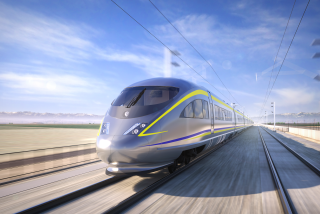Sandag OKs $2 Million for Commuter Rail Link
- Share via
A coalition of city officials Friday approved the spending of more than $2 million to establish a commuter rail link between Oceanside and San Diego, saying that government must move fast to counter the escalating number of cars on Interstate 5.
The board of directors of the San Diego Assn. of Governments (Sandag) unanimously approved spending the sum--to be matched by state funds--to commence a $4.15-million effort to improve the Oceanside Transit Center and other facilities along existing Santa Fe Railway tracks stretching between the two cities.
“Considering that I-5 is approaching gridlock, I can’t think of a more important item or something more critical than this (implementing a commuter rail system) to north coastal planning,” Greg Luis, the Encinitas representative to Sandag, said at the group’s monthly meeting Friday.
“We cannot afford to move slowly on this matter,” Luis said.
The action taken by Sandag marks the first allocation of funds amassed through Proposition A, a county ballot measure passed in November, 1987, that set a 0.5% sales tax increase for mass transit improvement in San Diego County.
A sum of $70 million was specifically designated in that omnibus initiative to establish an efficient and affordable commuter rail system from North County to downtown San Diego and reduce I-5 congestion.
Under the supervision of Sandag, the Metropolitan Transit Development Board (MTDB) and the North County Transit Development Board (NCTD) have jointly commissioned studies to determine how to implement the commuter rail system, which they hope to begin by 1992.
Initial plans outline a system that would make four round trips--with nine stops each way--during peak morning and evening commuter hours. By the year 2005, with six trains in operation, transportation planners project, car volume would be reduced by 50%. Studies show that nearly 200,000 cars pass through the I-5 and I-805 juncture each day.
But, for such lofty goals to be realized, several costly hurdles need to be cleared--none more important or more expensive than purchasing the right of way to the Santa Fe tracks.
Robert Welk, a Santa Fe vice president, made it clear to Sandag members Friday that the company is interested in selling its tracks.
But Michael Zdon, a senior Sandag transportation planner, said two tough problems need to be addressed: One, determine a price for the tracks; two, arrange a financial package for the purchase.
“One way of determining the value of the tracks is to appraise all the properties adjacent to the tracks,” Zdon said. “As you can imagine, it’s going to be costly considering that this project runs along the coastal corridor and land value there is at a premium.
“Another option is simply for us to make an outright offer. Government only has X amount of dollars to purchase the tracks. We can tell them that’s all we can afford. The railroad might accept that kind of offer, depending on how badly they need the money.”
However, Zdon said Santa Fe would most likely reject any sum offered strictly from the county’s coffers. The only financial source Sandag has to purchase the tracks is Proposition A funds, and most of it--$35 million to $40 million--is needed to build rail stations and to buy train equipment, leaving little to purchase tracks.
But, because Santa Fe wants to sell all of its I-5 corridor track from Fullerton to San Diego as a complete package, Zdon said there is an opportunity for Orange and San Diego counties to gain state assistance to purchase the right of way.
Sen. William Craven, instrumental in organizing a 1987 state-sponsored study to evaluate rail transit, agrees that a commuter project can only happen with state funds.
“I don’t think this can be done unless the state becomes a partner,” Craven said.
More to Read
Sign up for Essential California
The most important California stories and recommendations in your inbox every morning.
You may occasionally receive promotional content from the Los Angeles Times.













